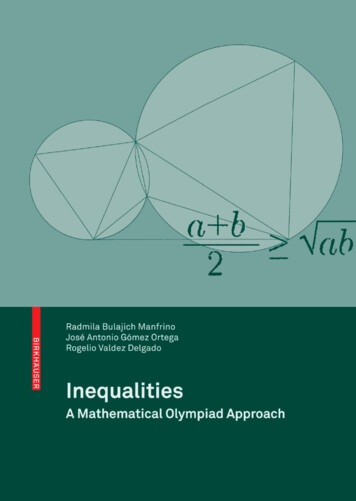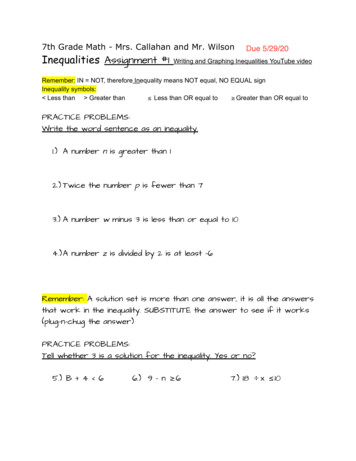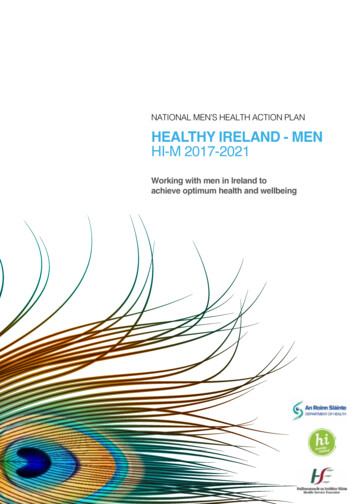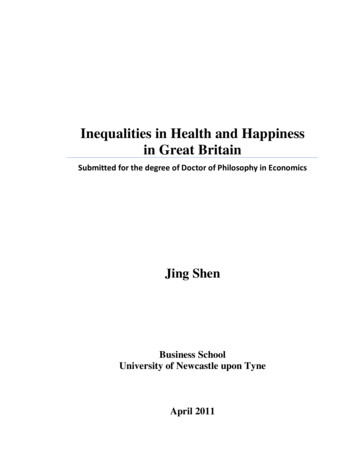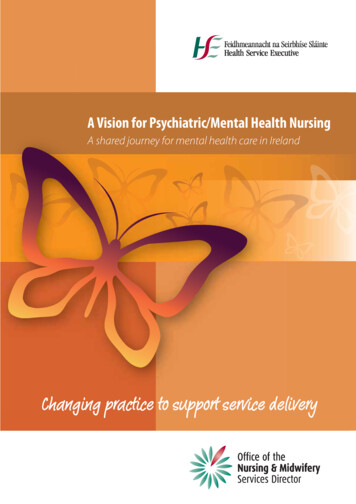
Transcription
INEQUALITIES IN HEALTHIN IRELAND - HARD FACTSJoe Barry – Hamish Sinclair – Alan Kelly– Ros O’Loughlin – Deirdre Handy – Tom O’DowdDepartment of Community Health & General Practice, Trinity College, DublinSeptember 2001
INEQUALITIES IN HEALTHIN IRELAND - HARD FACTSJoe Barry – Hamish Sinclair – Alan Kelly– Ros O’Loughlin – Deirdre Handy – Tom O’DowdDepartment of Community Health & General Practice, Trinity College, DublinSeptember 2001
THIS REPORT IS DEDICATED TO DR FIONA BRADLEYFRONT COVER IMAGE: Paul Seawright, Tangled Trees 2DETAILS:Courtesy of the Kerlin Gallery, DublinColour type C print on aluminium (edition of 6) PS08600Further copies of this report are available from the Department of Community Health & General Practice,Trinity College, Dublin. Price a20
CONTENTSACKNOWLEDGEMENTS4FOREWORD5SUMMARY7LIST OF FIGURES8LIST OF TABLES11GLOSSARY OF TERMS13CHAPTER 116INTRODUCTION17HOW WE DID IT19CHAPTER 222RESULTS:SECTION 1 - NATIONAL MORTALITY DATA22SECTION 2 - PERINATAL REPORTING SYSTEM34SECTION 3 - NATIONAL PSYCHIATRIC INPATIENT REPORTING SYSTEM40SECTION 4 - HOSPITAL IN-PATIENT ENQUIRY50SECTION 5 - NATIONAL DRUG TREATMENT REPORTING SYSTEM54SECTION 6 - UNKNOWNS60CHAPTER 368REPORTS GATHERING DUST69NATIONAL HEALTH INFORMATION STRATEGY - END OF UNHEALTHY DATA?71CHAPTER NICAL ANNEX76B.DATA INPUT FORMS:801.PERINATAL REPORTING SYSTEM822.HOSPITAL IN-PATIENT ENQUIRY833.NATIONAL PSYCHIATRIC INPATIENT REPORTING SYSTEM844.NATIONAL DRUG TREATMENT REPORTING SYSTEM85
PAGE 5ACKNOWLEDGEMENTSThis work has been funded by the Health Research Board. We are particularly grateful to thecustodians and managers of the various datasets that have been analysed, in particular:National Mortality DatasetHugh Magee - Department of Health and ChildrenPerinatal Reporting SystemHugh Magee - Department of Health and ChildrenHospital In-Patient EnquiryAnne Clifton - Economic and Social Research InstituteNational Psychiatric InPatient Reporting SystemCiaran Browne, Antoinette Daly - Health Research BoardNational Drug Treatment Reporting SystemRos Moran, Mary O'Brien - Health Research BoardPAGE 5
PAGE 6FOREWORDI am delighted to be asked to write the foreword to this most important report on "Inequalities inHealth in Ireland – Hard Facts" from the Department of Community Health and General Practice inTrinity College, Dublin.Among the issues which have come to the forefront in recent times in the debate on health isthat of "health inequalities", a concept which describes the differentials in health experiencebetween different sections of our population by reference to such indicators as morbidity andpremature mortality. Related to this also is the problem of inequitable access to health servicesbased on need.This report, while it recognises the genuine difficulties presented by incomplete and inadequateroutine data, nevertheless confirms the broad international experience of significantly highermortality rates for people from lower socio-economic groups for all causes and for ischaemic heartdisease, cancer and injuries and poisonings. In the context in which the general Irish experience inthis regard is significantly inferior to that of the rest of the European Union, the experience of poorIrish people must be regarded as intolerable.Other indicators in the area of psychiatric admissions, perinatal health and drug treatment all point tothe same differentials in experience as between the poorer and better off sections of our population.While certain important conclusions can be drawn from the data, the report identifies the limitationsof the routine data sets available. It suggests that routine data sets need to be altered so that healthinequalities can be measured by reference to these data sets (a recommendation also made in the1999 CMO’s Report) and also that once-off major epidemiological studies from time to time wouldbe appropriate. The report also suggests that these data and information deficits can best beaddressed in the context of the emerging National Health Information Strategy.To address the serious problems identified in this report, decisions need to be taken at the broadintersectoral policy level and also at health policy level. The existing partnership process and theNational Anti-Poverty Strategy process within it, provide a platform and opportunity for broad policyaction and the forthcoming Health Strategy will provide a framework for health sector responses.Those interested in further analysing and, in particular, doing something about health inequalitieswill be grateful for this report and its authors are to be congratulated on its publication.Dr. James KielyChief Medical OfficerDepartment of Health and ChildrenPAGE 6
PAGE 8SUMMARYThe following are the principal findings of this report: In 1996 unskilled manual men were twice as likely to die as higher professionalmen (standardised ratio 122 versus 64). In 1996 unskilled manual men were eight times more likely to die from an accidentalcause than higher professional men (standardised ratio 136 versus 17). In 1996 you were almost four times as likely to be admitted to hospital for the firsttime for schizophrenia if you were in the unskilled manual category than if youwere a higher professional (standardised ratio of 130 versus 35). In the early 1990s women in the unemployed socio-economic group were overtwice as likely to give birth to low birth weight babies as women in thehigher professional group (standardised ratio of 140 versus 66). Persons with socio-economic group ‘unskilled manual’ have worse healththan professional groups in all years and for all the conditions which are analysedin this report. Persons with socio-economic group ‘unknown’ have consistently worse health thanthose in socio-economic group ‘unskilled manual’. The proportion of persons where socio-economic group is unknown is growingin each database. Mortality seems to be worse in medium sized towns than in cities or in rural areas. Data from the Perinatal Reporting System has not been published for eight years. HIPE is of practically no use in making comment on socio-economic differences.PAGE 8
PAGE 9LIST OF FIGURESNational Mortality DataFigure 1.1Standardised mortality ratios (SMRs) and 95% confidence intervals forall causes (males 15-64 years) by socio-economic group, Ireland 1996Figure 1.2Standardised mortality ratios (SMRs) and 95% confidence intervals forall causes (males 15-64 years) for unskilled manual and professional(higher lower) socio-economic groups, Ireland 1981,1986, 1991, 1996Figure 1.3Standardised mortality ratios (SMRs) and 95% confidence intervalsfor ischaemic heart disease (ICD codes 410-414) (males 15-64 years)by socio-economic group, Ireland 1996Figure 1.4Standardised mortality ratios (SMRs) and 95% confidence intervals for ischaemicheart disease (ICD codes 410-414) (males 15-64 years) for unskilled manualand professional (higher lower) socio-economic groups, Ireland 1981,1986, 1991, 1996Figure 1.5Standardised mortality ratios (SMRs) and 95% confidence intervals forneoplasms (ICD codes 140-239)(males 15-64 years) by socio-economicgroup, Ireland 1996Figure 1.6Standardised mortality ratios (SMRs) and 95% confidence intervals forneoplasms (ICD codes 140-239)(males 15-64 years) for unskilled manual andprofessional (higher lower) socio-economic groups, Ireland 1981,1986, 1991, 1996Figure 1.7Standardised mortality ratios (SMRs) and 95% confidence intervals forinjuries and poisonings (ICD codes 800-999) (males 15-64 years) bysocio-economic group, Ireland 1996Figure 1.8Standardised mortality ratios (SMRs) and 95% confidence intervals forinjuries and poisonings (ICD codes 800-999)(males 15-64 years) for unskilledmanual and professional (higher lower) socio-economic groups,Ireland 1981,1986, 1991, 1996Perinatal Reporting SystemPAGE 9Figure 2.1Standardised perinatal mortality ratios and 95% confidence intervals bysocio-economic group, Ireland 1990-1993Figure 2.2Standardised perinatal mortality ratios and 95% confidence intervals for unskilledmanual and professional (higher lower) socio-economic groups, Ireland 1986-1993
PAGE 10Figure 2.3Standardised low birth weight ratios and 95% confidence intervals bysocio-economic group, Ireland 1990-1993Figure 2.4Standardised low birth weight ratios and 95% confidence intervals for unskilledmanual and professional (higher lower) socio-economic groups, Ireland 1986-1993Figure 2.5Percentage of births to single teenagers aged15-17 as a proportion of allbirths by year, 1986-1993National Psychiatric InPatient Reporting SystemFigure 3.1Standardised discharge ratios and 95% confidence intervals for all 1st psychiatricadmissions (males 15-64 years) by socio-economic group, Ireland 1996Figure 3.2Standardised discharge ratios and 95% confidence intervals for all 1stpsychiatric admissions (males 15-64 years) for unskilled manual andprofessional (higher lower) socio-economic groups, Ireland 1991 and1996Figure 3.3Standardised discharge ratios and 95% confidence intervals for schizophrenia1st admissions (males 15-64 years) by socio-economic group, Ireland 1996Figure 3.4Standardised discharge ratios and 95% confidence intervals for schizophrenia1st admissions (males 15-64 years) for unskilled manual and professional(higher lower) socio-economic groups, Ireland 1991 and1996Figure 3.5Standardised discharge ratios and 95% confidence intervals for depressivedisorders 1st admissions (males 15-64 years) by socio-economic group, Ireland 1996Figure 3.6Standardised discharge ratios and 95% confidence intervals for depressivedisorders 1st admissions (males 15-64 years) for unskilled manual andprofessional (higher lower) socio-economic groups, Ireland 1991 and 1996Figure 3.7Standardised discharge ratios and 95% confidence intervals for alcoholicdisorders 1st admissions (males 15-64 years) by socio-economic group, Ireland 1996Figure 3.8Standardised discharge ratios and 95% confidence intervals for alcoholicdisorders 1st admissions (males 15-64 years) for unskilled manual andprofessional (higher lower) socio-economic groups, Ireland 1991 and1996Figure 3.9Standardised discharge ratios and 95% confidence intervals for personalitydisorders 1st admissions (males 15-64 years) by socio-economic group, Ireland 1996Figure 3.10Standardised discharge ratios and 95% confidence intervals for personalitydisorders 1st admissions (males 15-64 years) for unskilled manual andprofessional (higher lower) socio-economic groups, Ireland 1991 and1996PAGE 10
PAGE 11National Drug Treatment Reporting SystemFigure 5.1Trends in measures of education and employment for first time treatmentcontacts (opiates) 1990-1996, Dublin onlyFigure 5.2Plot of the relationship between a DED’s deprivation level and the meanstandardised first treatment contact ratio (SFTCR) value, with 95% confidenceintervals, for opiate misuse 15-34 year olds in the greater Dublin area, 1995-1996Figure 5.3Map of greater Dublin area district electoral divisions (DEDs) with bothsignificantly high standardised first treatment contact ratios (SFTCR)and high deprivationUnknown socio-economic groupPAGE 11Figure 6.1Percentages of persons with unknown socio-economic group, NationalMortality Dataset (males 15-64) 1981 and 1996, Perinatal Reporting System(females) 1986 and 1993, National Psychiatric InPatient Reporting System(males 15-64) 1991 and 1996Figure 6.2Percentage of male deaths (15-64 years) in the ‘unknown’ socio-economicgroup compared to all other socio-economic groups by county, Ireland 1996(National Mortality Dataset)Figure 6.3Marital status within the ‘unknown’ socio-economic group compared to allother socio-economic groups (National Mortality Dataset)Figure 6.4Percentage of women in the ‘unknown’ socio-economic group comparedto all other socio-economic groups by age, Ireland 1986-1993(Perinatal Reporting System)Figure 6.5Percentage of women in the ‘unknown’ socio-economic group comparedto all other socio-economic groups by county, Ireland 1986-1993(Perinatal Reporting System)Figure 6.6Percentage of males (15-64 years) in the ‘unknown’ socio-economic groupcompared to all other socio-economic groups by age, Ireland 1996 (NationalPsychiatric InPatient Reporting System)Figure 6.7Percentage of males (15-64 years) in the ‘unknown’ socio-economic groupcompared to all other socio-economic groups by county, Ireland 1996 (NationalPsychiatric InPatient Reporting System)Figure 6.8Marital status within the ‘unknown’ socio-economic group comparedto all other socio-economic groups, Ireland 1996 (National PsychiatricInPatient Reporting System)
PAGE 12LIST OF TABLESTable 0.1Routine health datasets analysed for this reportTable 0.2Content of the datasetsNational Mortality DataTable 1.1Standardised mortality ratios (SMRs) and total deaths for all causes,by county, Ireland 1994-1996Table 1.2Standardised mortality ratios (SMRs) and total deaths for ischaemic heartdisease (ICD codes 410-414), by county, Ireland 1994-1996Table 1.3Standardised mortality ratios (SMRs) and total deaths for neoplasms (ICDcodes 140-239), by county, Ireland 1994-1996Table 1.4Standardised mortality ratios (SMRs) and total deaths for injuries andpoisonings (ICD codes 800-999), by county, Ireland 1994-1996Table 1.5Standardised mortality ratios (SMRs) and total deaths for all causes, for 88rural and urban districts and county boroughs, Ireland 1994-1996Table 1.6Standardised mortality ratios (SMRs) and total deaths for ischaemic heartdisease (ICD codes 410-414), for 88 rural and urban districts and countyboroughs, Ireland 1994-1996Table 1.7Standardised mortality ratios (SMRs) and total deaths for neoplasms (ICD codes140-239), for 88 rural and urban districts and county boroughs, Ireland 1994-1996Table 1.8Standardised mortality ratios (SMRs) and total deaths for injuries andpoisonings (ICD codes 800-999), for 88 rural and urban districts and countyboroughs, Ireland 1994-1996Perinatal Reporting SystemTable 2.1Standardised perinatal mortality ratios (SPMRs) and perinatal deaths bycounty, Ireland 1986-1993Table 2.2Standardised low birth weight ratios (SLBWRs) and number of low birthweight births, by county, Ireland 1986-1993Table 2.3Age standardised incidence (ASI) of births to single teenagers aged 15-17by county, 1986-1993PAGE 12
PAGE 13National Psychiatric InPatient Reporting SystemTable 3.1Standardised discharge ratios (SDRs) and total discharges for all 1st psychiatricadmissions (male and female) by county, Ireland 1991 and 1996 combinedTable 3.2Standardised discharge ratios (SDRs) and total discharges for all 1st admissionsfor schizophrenia (male and female) by county, Ireland 1991 and 1996 combinedTable 3.3Standardised discharge ratios (SDRs) and total discharges for all 1stadmissions for depressive disorders (male and female) by county, Ireland 1991and 1996 combinedTable 3.4Standardised discharge ratios (SDRs) and total discharges for all 1stadmissions for alcoholic disorders (male and female) by county,Ireland 1991 and 1996 combinedTable 3.5Standardised discharge ratios (SDRs) and total discharges for all 1stadmissions for personality disorders (male and female) by county,Ireland 1991 and 1996 combinedHospital In-Patient Reporting SystemTable 4.1Standardised discharge ratios for ischaemic heart disease (ICD codes410-414) by county, Ireland 1997Table 4.2Standardised discharge ratios for neoplasms (ICD codes 140-239) bycounty, Ireland 1997Table 4.3Standardised discharge ratios for injuries and poisonings (ICD codes800-999) by county, Ireland 1997Table 4.4Standardised discharge ratios for coronary artery bypass graft bycounty, Ireland 1997Table 4.5Standardised discharge ratios for angioplasty by county, Ireland 1997Unknown socio-economic groupTable 6.1PAGE 13Assorted standardised ratios for ‘unknown’ category, National MortalityDataset (1996), Perinatal Reporting System (1993) and National PsychiatricInPatient Reporting System (1996)
PAGE 14GLOSSARY OF TERMSConfidence Interval (95%)The range of values in which the true value of a parameter (e.g. proportion) is likely to be found.By convention a 95% confidence interval is usually calculated i.e. the range that will include thetrue value 95% of the time.DatabaseA collection of values, usually containing several variables, which is constantly maintainedand updated.Health inequalitiesHealth inequality is the "differences in the prevalence or incidence of health problems betweenindividual people of higher and lower socio-economic status."Reference: World Health Organisation. City Health Profiles. Geneva 1998.Health inequitiesIt is important to note that inequity is not the same as or synonymous with inequality. Healthinequalities count as inequities only when they are avoidable, unnecessary, and unfair.Reference: Goran Dahlgren and Margaret Whitehead, Policies and Strategies to Promote Social Equality in Health(Stockholm: Institute of Future Studies, 1991).Hospital In-Patient Enquiry (HIPE)The Hospital In-patient Enquiry scheme records details on deaths and discharges for all the acutepublic hospitals in the country. Information is collected on principal diagnoses and principalprocedures performed.National Mortality DatasetDeaths classified by year of death, excluding late registrations but including deaths of nonresidents. The Ninth Revision of the International Classification of Diseases, Injuries and Causes ofDeath (ICD-9) has been used to classify deaths in Ireland by cause since 1979. The CentralStatistics Office is responsible for compiling registered deaths in computerised format.National Psychiatric InPatient Reporting SystemThis system records information on discharges for all in-patient psychiatric admissions in thecountry through all public hospitals and some private hospitals. It gathers information by principalpsychiatric diagnosis.PAGE 14
PAGE 15National Drug Treatment Reporting System (NDTRS)The NDTRS is an epidemiological database providing information on treated drug misuse in theRepublic of Ireland. Drug misuse which occurs outside the treatment context is not included. Thedatabase is maintained by the Drug Misuse Research Division of the Health Research Board.Reporting began in 1990 and for the first five years covered treated drug misuse in Dublin only. In1995 the Reporting System was expanded to cover the entire country. Drug misuse in the NDTRSis defined as the taking of an illegal and/or legal drug or drugs (excluding alcohol other than as asecondary drug of misuse and tobacco) which harms the physical, mental or social well-being ofthe individual, the group or society.Perinatal mortality rateNumber of stillbirths plus number of liveborn babies who die before the end of the first seven daysof life per annum divided by total number of live and stillbirths.Perinatal periodThe time from 28 weeks gestation (28 weeks of pregnancy) or when the foetus reaches a weightof 500 grammes whichever occurs first, to 1 week after birth. In 1995 the definition changed andthe relevant gestation period became 24 weeks.Perinatal Reporting SystemThis system comprises a notification of birth form filled out by all maternity hospitals on the birth ofeach baby, collecting information on the mother, the pregnancy and the infant. These data form thePerinatal Reporting System database.Qualitative researchSocial research which is carried out in the field (natural settings) and analysed largely in nonstatistical ways.Quantitative researchThe measurement and analysis of observations in a numerical way.Routine data sourcesThis refers to data which are continually collected by various sources e.g. Perinatal ReportingSystem, Hospital In-Patient Enquiry (HIIPE), National Psychiatric InPatient Reporting System,National Mortality Dataset.Social classSegments of the population sharing broadly similar types and levels of resources, broadly similarstyles of living and some shared perception of their collective condition.PAGE 15
PAGE 16Socio-economic group (SEG)A classification system used to bring together persons with similar social and economic status onthe basis of the level of skill or educational attainment acquired. SEG of those 15 years and overis determined by their occupational and employment status. Persons on home duties or atschool/college, who are members of a family unit are generally classified to the SEG of the personin the family on whom they were deemed dependant. SEG of married women is often determinedby their husband’s occupation.Standardised mortality ratio (SMR)Method of comparing mortality of one population with that of another. It is obtained by calculatingthe expected number of deaths in a given population (if the population had the same mortality as thestandard population) and dividing the observed number of deaths by the expected number. Otherstandardised ratios (e.g. standardised low birth weight ratios) are calculated in the same way.UnknownsThe Irish socio-economic group (SEG) classification is a nominal grouping of occupationscomprising 11 categories plus a residual 'unknown' category for individuals who cannot be codeddue to insufficient information. Occupations are grouped in each SEG on the basis that they aregenerally similar as regards the level of skill or educational attainment acquired. A major weaknessof the Irish SEG classification is the lack of ordinality in the scaling of occupations and in particularthe grouping of all farmers in one category irrespective of farm size or income accruing from thefarm. It is also felt that some categories of the Irish SEG classification contain an inappropriatecombination of occupations. (O'Hare 1991)VariablesMeasures of interest that vary across individuals, groups or geographic areas, for example, age,sex, socio-economic group, mortality rate.PAGE 16
CHAPTER ONE
PAGE 18INTRODUCTIONFairness is good for health and unfairness is bad for healthConcerns about the health of the poor have existed in Ireland since the early 1800s. Structureswere put in place through the Poor Law in 1838 and the Dispensary Service from 1851 toprovide limited healthcare for poor people. The services fell far short of the needs of the peopleand the political debate about the Health Act of 1970 expressed concerns about ‘injustice’ inhealthcare provision. Over the last two decades an international debate has moved frominjustice to inequalities. There is now compelling international research indicating that healthinequalities occur throughout the industrialised world.1 Such inequalities are directly related toincreased ill health and early death among significant numbers of our citizens. Medicine ingeneral is beginning to realise that it can do little about inequalities in society without a widerpolitical debate. However, commentators increasingly focus on equity in healthcare whichintroduces the concept of fairness in the distribution of medical care (Shaping a HealthierFuture 1994).2 Ireland is a good place to investigate the issue of fairness as it has wellestablished systems of public and private medical care existing side by side. Such systems arerevealing anecdotal cases of inequities where patients with similar illnesses only receive promptcare on the basis of ability to pay. Spending on health is important as in countries which spendmuch more on their health than Ireland, the better off live several years longer and have fewerillnesses than the poor. Indeed there is now evidence that health spending in the private sectorin Ireland is above the EU average while spending in the public sector continues to lag behindthe EU average (OECD).3 Politicians have not welcomed research on inequalities in health aswas famously demonstrated when the seminal, British Government funded 'Black Report' oninequalities was released on an August bank holiday Monday in 1980 in restricted numbers toa restricted audience by Mrs. Thatcher’s government.4The Black Report on inequalities in health presented evidence of marked differentials in healthoutcomes " from birth to old age those at the bottom of the social scale have much poorer healthand quality of life than those at the top gender, area of residence and ethnic origin also have adeep impact". Ten years later researchers had concluded that socio-economic inequalities in healthoutcome had widened and " .suggest that further widening of mortality differentials may beexpected."5,6 The existence of wide and widening socio-economic differences in health shows howextraordinarily sensitive health remains to socio-economic circumstances.7,8There is also evidence that unless medical care is targeted appropriately, that it may contribute towidening of differences between socio-economic groups because of the greater capacity of welloff people to obtain medical care.9Approaches to policy in Ireland - insufficient actionWhile the debate about inequalities in the United Kingdom has become polarised and politicised,in the Netherlands cross party agreement has led to a consensus based approach to addressinginequalities in health.10 The Dutch have set up a five year research programme with the aim ofraising consciousness among the scientific community, to increase knowledge of inequalities andtheir causes and, crucially, to have an effect on health policy.PAGE 18
PAGE 19The Dutch have set up a five year research programme withthe aim of raising consciousness among the scientificcommunity, to increase knowledge of inequalities and theircauses and, crucially, to have an effect on health policy.The approach in Ireland has taken the Dutch rather than the UK approach, but without the robuststructure to move from policy to action. In fairness there appears to be a seriousness of purposethat is severely handicapped by poor information systems, lack of research and difficulties inmedium to long term planning. The Department of Health and Children’s widely accepted strategydocument Shaping a Healthier Future2 has set the scene by defining the principles of equity, qualityand accountability for the development of our health services. Considerable attention was drawnin the document to inequalities in health in selected sub-groups of the Irish population and indeedsince the publication of the strategy the reduction in inequalities in healthcare has been a priority.The first ever Chief Medical Officer’s report11 builds on this theme and acknowledges that researchis urgently required to establish the extent of health inequality in Ireland and its complex causes. Inthe policy document Programme for Prosperity and Fairness12 one objective is "to improve accessto quality healthcare services in order to strengthen social inclusion and cohesion and also tomonitor socio-economic health inequalities". The Programme document devotes further attentionto marginalised groups and inequalities and states "resources will be allocated to health researchas part of a comprehensive approach to ensuring adequate medium and long term planning ofhealth provision. Data systems will be adapted to enable dis-aggregation of health access andoutcomes across National Anti-Poverty Strategy target groups. This data will be monitored andreported on at national level." The Health Research Board's consultation document MakingKnowledge Work for Health13 emphasises that epidemiological information needs to be availableand translated into measures for the health of the population. The real test is, however, not in doingthe research but in translating it into effective policy and action as an expression of our society’scommitment to equity in healthcare.This research In 1998, through a Health Research Board grant, we obtained access to a range of databasesfrom the Irish health services with a view to examining inequalities in health and healthcare inIreland. Some databases make socio-economic differentiation possible; in others, data ondifferences in health are only examinable at a geographic level. Unfortunately no databaseprovides analysis by social class.Our project has two principal objectives. Using routine health information systems: To look for and present evidence of inequalities in health and healthcare in Ireland over thepast twenty years. To make recommendations on data collection so that routine health information systemscan be used to measure changes in health status and healthcare uptake, particularly indifferent social groups of the population.PAGE 19
PAGE 20HOW WE DID ITOn receipt of the Health Research Board grant the managers or custodians of five datasets werewritten to, stating the objectives of our exercise and seeking permission to access the data. In allcases permission was forthcoming. The datasets differ widely in their construction, their objectives,their legal status and their size. Five datasets are cited in this report. These are: National Mortality Dataset Perinatal Reporting System National Psychiatric InPatient Reporting System Hospital In-Patient Enquiry National Drug Treatment Reporting SystemThere is a risk with access to such large datasets that the data processing and analysis itself couldtake an inordinate length of time. Therefore data for each year for each dataset were not sought.A summary description of each dataset is given in Table 0.1 and an outline of the variables that canshow inequalities, collected in each dataset, is given in Table 0.2. A more detailed account of theanalytical methods used and the reasons for using them are given in the Technical Annex, appendixA. A copy of the data entry sheet for four of the datasets is given in appendix B.PAGE 20
PAGE 21Table 0.1 Routine health datasets analysed for this RINATALREPORTINGSYSTEMECONOMIC &SOCIALRESEARCHINSTITUTE:ANNUALREPORTAVAILABLEMOST RECENTYEAR FORWHICH PRINTEDREPORT ISAVAILABLEYEARSANALYSED INTHIS PROJECTYES19971981, 1986,1991,1994,1995, 199653,000YES19931986 - 1
SUMMARY The following are the principal findings of this report: In 1996 unskilled manual men were twice as likely to die as higher professional men (standardised ratio 122 versus 64). In 1996 unskilled manual men were eight times more likely to die from an accidental cause than higher professional men (standardised ratio 136 versus 17).
